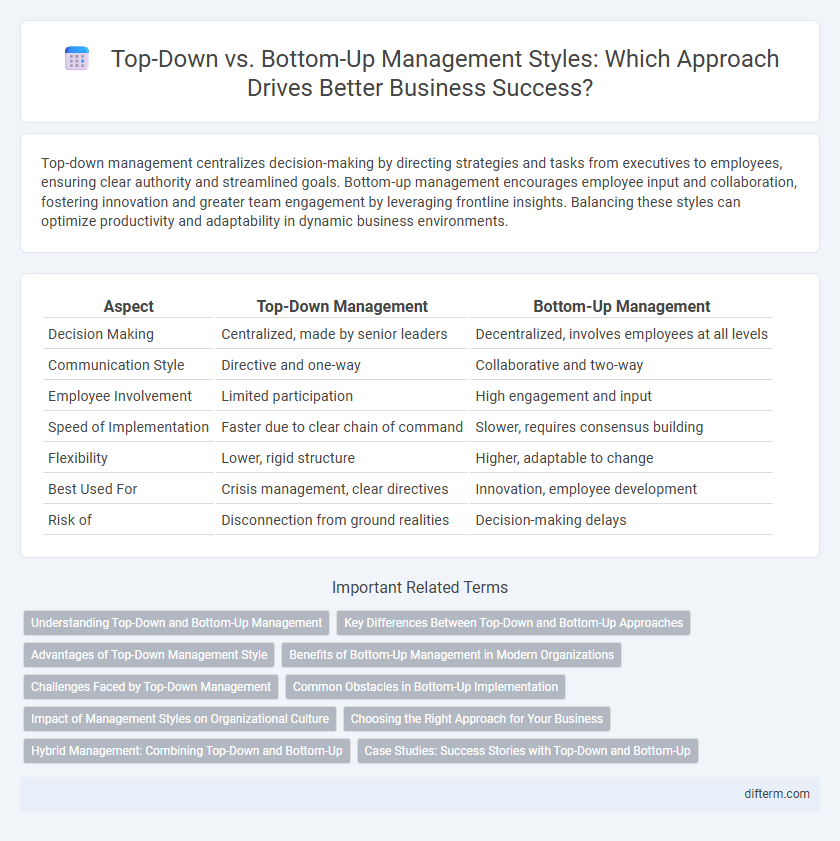Top-down management centralizes decision-making by directing strategies and tasks from executives to employees, ensuring clear authority and streamlined goals. Bottom-up management encourages employee input and collaboration, fostering innovation and greater team engagement by leveraging frontline insights. Balancing these styles can optimize productivity and adaptability in dynamic business environments.
Table of Comparison
| Aspect | Top-Down Management | Bottom-Up Management |
|---|---|---|
| Decision Making | Centralized, made by senior leaders | Decentralized, involves employees at all levels |
| Communication Style | Directive and one-way | Collaborative and two-way |
| Employee Involvement | Limited participation | High engagement and input |
| Speed of Implementation | Faster due to clear chain of command | Slower, requires consensus building |
| Flexibility | Lower, rigid structure | Higher, adaptable to change |
| Best Used For | Crisis management, clear directives | Innovation, employee development |
| Risk of | Disconnection from ground realities | Decision-making delays |
Understanding Top-Down and Bottom-Up Management
Top-Down management centers on a hierarchical approach where decisions are made by senior leadership and communicated downward for execution, ensuring clear direction and control. Bottom-Up management emphasizes employee involvement by encouraging feedback and ideas from all levels to foster innovation and engagement. Understanding these contrasting styles helps businesses optimize decision-making processes, improve organizational culture, and align strategies with company goals.
Key Differences Between Top-Down and Bottom-Up Approaches
Top-down management emphasizes centralized decision-making where executives set strategic goals and directives that cascade down through hierarchical levels, ensuring uniformity and clear accountability. Bottom-up management fosters employee participation by encouraging input and ideas from all organizational levels, promoting innovation and adaptability through collaborative problem-solving. Key differences include the direction of communication flow, decision-making authority concentration, and the balance between control and empowerment within the corporate structure.
Advantages of Top-Down Management Style
Top-down management style streamlines decision-making by establishing clear authority and direction from upper leadership, enabling faster implementation of strategies. This approach ensures consistency across departments and aligns organizational goals effectively, reducing ambiguity and conflict. Centralized control in top-down management facilitates accountability and simplifies coordination in large or complex businesses.
Benefits of Bottom-Up Management in Modern Organizations
Bottom-up management empowers employees by fostering collaboration and innovation, leading to increased engagement and higher productivity in modern organizations. This approach enhances decision-making quality by leveraging diverse perspectives across all levels of the company. Implementing bottom-up management also improves adaptability and responsiveness to market changes, critical factors for maintaining competitive advantage.
Challenges Faced by Top-Down Management
Top-down management often encounters challenges such as limited employee engagement and resistance to change due to rigid decision-making hierarchies. This centralized approach can slow adaptability in dynamic business environments, reducing operational efficiency. Communication barriers between leadership and frontline staff frequently lead to misunderstandings and decreased morale.
Common Obstacles in Bottom-Up Implementation
Common obstacles in bottom-up implementation include resistance from middle management, which can hinder the flow of ideas and decision-making autonomy. Lack of clear communication channels between frontline employees and senior leadership often leads to misalignment of goals and priorities. Additionally, insufficient training and empowerment of employees prevent effective participation, reducing the overall impact of bottom-up initiatives.
Impact of Management Styles on Organizational Culture
Top-down management fosters a culture of clear hierarchy and centralized decision-making, often resulting in consistent policies but limited employee autonomy. In contrast, bottom-up management cultivates an inclusive environment where employee input drives innovation and engagement, enhancing adaptability and morale. The choice between these styles significantly influences organizational culture by shaping communication patterns, authority distribution, and employee empowerment.
Choosing the Right Approach for Your Business
Selecting the appropriate management style hinges on your business size, culture, and agility needs; top-down approaches provide clear direction and faster decision-making for hierarchical organizations, while bottom-up methods encourage employee engagement and innovation in collaborative environments. Companies with complex, rapidly changing markets often benefit from bottom-up strategies that harness diverse insights, whereas more traditional industries may thrive with the structure and control offered by top-down management. Evaluating your organizational goals, communication flow, and adaptability requirements ensures the chosen approach aligns with long-term success and operational efficiency.
Hybrid Management: Combining Top-Down and Bottom-Up
Hybrid management integrates top-down and bottom-up approaches to leverage strategic oversight while fostering employee input, enhancing decision-making processes and organizational agility. This style balances executive directives with grassroots innovation, improving responsiveness and stakeholder engagement. Effective hybrid management can drive both operational efficiency and cultural cohesion in complex business environments.
Case Studies: Success Stories with Top-Down and Bottom-Up
Case studies reveal that top-down management excels in rapid decision-making during crises, as seen in Apple's product launch strategy under Steve Jobs, ensuring unified vision and swift execution. Conversely, bottom-up approaches foster innovation and employee engagement, exemplified by Google's use of employee-driven projects generating breakthrough technologies like Gmail. Companies integrating both styles strategically often achieve balanced agility and creativity, maximizing organizational performance.
Top-Down vs Bottom-Up (management style) Infographic

 difterm.com
difterm.com